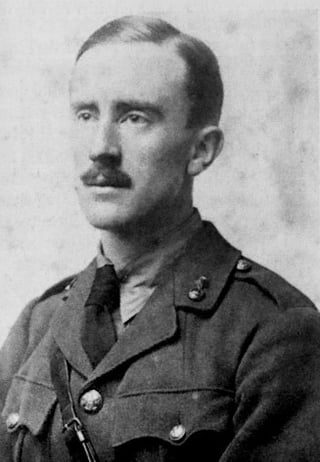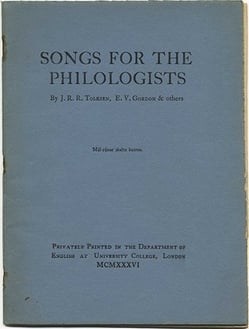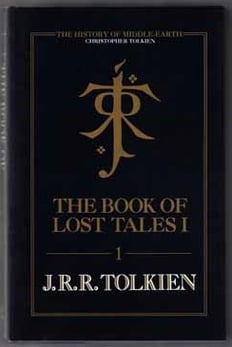When you hear the name of certain authors, you immediately draw associations with a style or idea. Hemingway = ex-patriotism. Fitzgerald = The Jazz Age. Kerouac = The Beats and their nomadic existence. And J.R.R. Tolkien = bringing the fantasy and science-fiction genres into the mainstream consciousness.
 The Hobbit. The Lord of the Rings. The Silmarillion. Tolkien is best known for creating immersive, detailed worlds populated with fantastical characters both human and otherwise. His novels and short stories transport the reader to places and times of high-stakes adventure, soaring action and drama, and deep, philosophical questions about identity, politics, and the human condition.
The Hobbit. The Lord of the Rings. The Silmarillion. Tolkien is best known for creating immersive, detailed worlds populated with fantastical characters both human and otherwise. His novels and short stories transport the reader to places and times of high-stakes adventure, soaring action and drama, and deep, philosophical questions about identity, politics, and the human condition.
But if you dig a little deeper into Tolkien’s literary career, you’ll find a number of books and projects that, while off the beaten path, show a different side of this legendary author while offering the same satisfying reading experience as his most famous works.
With that in mind, here are four unusual Tolkien publications that are not only worth seeking out, but that would be a boon to any Tolkien collection.
1. Songs for the Philologists (1936)
 Conceived as something of a pet project between Tolkien and writer E.V. Gordon, Songs for the Philologists is widely regarded as the rarest Tolkien text with an estimated 14 copies known in existence. The book contains roughly 30 poems and lyrics—14 authored by Tolkien—to traditional folk songs, and it was originally complied between 1921 and 1926 for Gordon’s students at the University of Leeds. The book was then printed and passed on to students at the University of London College by former Leeds student, A.H. Smith, who distributed the small number of copies without the permission of Tolkien or Gordon. Small printing aside, a majority of the existing copies were destroyed in a library fire in the mid to late 1930s.
Conceived as something of a pet project between Tolkien and writer E.V. Gordon, Songs for the Philologists is widely regarded as the rarest Tolkien text with an estimated 14 copies known in existence. The book contains roughly 30 poems and lyrics—14 authored by Tolkien—to traditional folk songs, and it was originally complied between 1921 and 1926 for Gordon’s students at the University of Leeds. The book was then printed and passed on to students at the University of London College by former Leeds student, A.H. Smith, who distributed the small number of copies without the permission of Tolkien or Gordon. Small printing aside, a majority of the existing copies were destroyed in a library fire in the mid to late 1930s.
2. The Father Christmas Letters (1976)
 While one may not take Tolkien to be a lover of children’s literature, it makes sense he would gravitate toward the genre given the fabulist nature of his work. Tolkien was indeed an advocate of children’s lit and the possibility of a child’s imagination, which is why between 1920 and 1942 he wrote a series of letters to his children in the voice and persona of Father Christmas. The letters, which when strung together created cohesive narratives, detailed Father Christmas’s experiences and journeys during the year, and Tolkien went so far as to have the letters delivered with stamps and envelopes right around Christmas day. The collection was released in 1976 after Tolkien’s death.
While one may not take Tolkien to be a lover of children’s literature, it makes sense he would gravitate toward the genre given the fabulist nature of his work. Tolkien was indeed an advocate of children’s lit and the possibility of a child’s imagination, which is why between 1920 and 1942 he wrote a series of letters to his children in the voice and persona of Father Christmas. The letters, which when strung together created cohesive narratives, detailed Father Christmas’s experiences and journeys during the year, and Tolkien went so far as to have the letters delivered with stamps and envelopes right around Christmas day. The collection was released in 1976 after Tolkien’s death.
3. The Book of Lost Tales (1983-1984)
 Published in two volumes, The Book of Lost Tales is referred to as the precursor to Tolkien’s 12-volume History of Middle Earth, and many literary scholars believe these two volumes also heavily influenced Tolkien’s The Silmarillion, though the stories in Book of Lost Tales contain different characters and plot lines. The collection was written while Tolkien was moving from hospital to hospital in recovery from illness and injury sustained while fighting in the Battle of the Somme during World War I, and a number of stories are said to be heavily informed by his experiences on the battlefield and in various convalescent facilities. What makes these volumes so interesting is that they provide a glimpse into how long Tolkien’s ideas for Middle Earth—and subsequently The Hobbit and Lord of the Rings—had been brewing, and how the kernel of a story idea can present itself in many different ways.
Published in two volumes, The Book of Lost Tales is referred to as the precursor to Tolkien’s 12-volume History of Middle Earth, and many literary scholars believe these two volumes also heavily influenced Tolkien’s The Silmarillion, though the stories in Book of Lost Tales contain different characters and plot lines. The collection was written while Tolkien was moving from hospital to hospital in recovery from illness and injury sustained while fighting in the Battle of the Somme during World War I, and a number of stories are said to be heavily informed by his experiences on the battlefield and in various convalescent facilities. What makes these volumes so interesting is that they provide a glimpse into how long Tolkien’s ideas for Middle Earth—and subsequently The Hobbit and Lord of the Rings—had been brewing, and how the kernel of a story idea can present itself in many different ways.
4. Language and Human Nature (N/A)
Language and Human Nature is not an available Tolkien publication—only partial copy exists in the University of Oxford library—but for the Tolkien fanatic or completest, it’s worth knowing about if no other reason than to impress your literary friends at your next dinner party. The book was a collaboration between Tolkien and author C.S. Lewis about the impact of language on communication and meaning. It’s believed work on the book began in the mid to late 1940s, and press releases from that era indicated a 1950 release was planned; however, the manuscript was never completed and the book never released. Literary historians thought the project was nothing more than a myth until a partial manuscript was discovered at Oxford in 2009 by Texas State University Professor Steven A. Beebe. The unfinished book contains several articles by Tolkien and Lewis separately, but it doesn’t include any pieces in which they collaborated.








